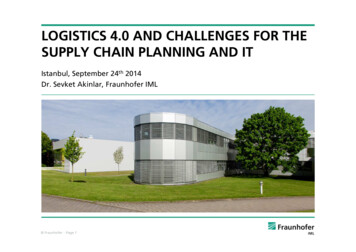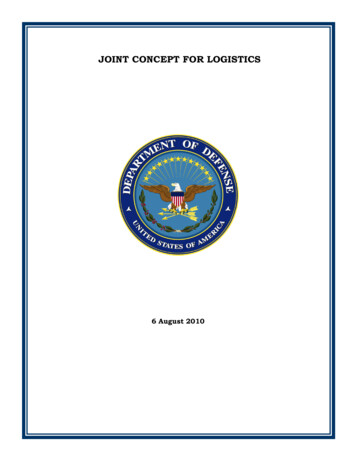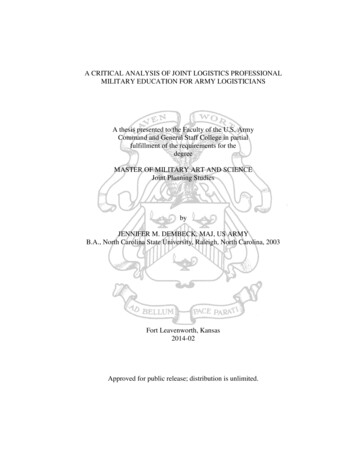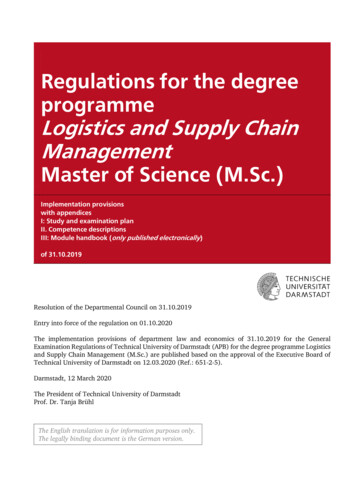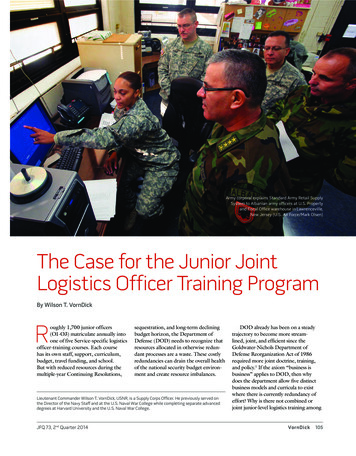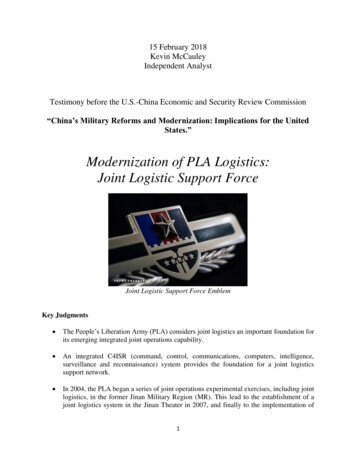
Transcription
15 February 2018Kevin McCauleyIndependent AnalystTestimony before the U.S.-China Economic and Security Review Commission“China’s Military Reforms and Modernization: Implications for the UnitedStates.”Modernization of PLA Logistics:Joint Logistic Support ForceJoint Logistic Support Force EmblemKey Judgments The People’s Liberation Army (PLA) considers joint logistics an important foundation forits emerging integrated joint operations capability. An integrated C4ISR (command, control, communications, computers, intelligence,surveillance and reconnaissance) system provides the foundation for a joint logisticssupport network. In 2004, the PLA began a series of joint operations experimental exercises, including jointlogistics, in the former Jinan Military Region (MR). This lead to the establishment of ajoint logistics system in the Jinan Theater in 2007, and finally to the implementation of1
force-wide joint logistics reforms under President Xi Jinping. The current reforms arescheduled for completion by the end of 2020. In late 2015 and early 2016, President Xi consolidated all military elements under theCentral Military Commission (CMC), including the establishment of a Logistic SupportDepartment with macro-management responsibilities. A Joint Logistic Support Force (JLSF)1 was established in September 2016 to unify jointlogistics forces at the strategic level and support the five new joint theater commands. The JLSF is key to building a modern logistics support system, and critical forimplementing integrated joint operations, supporting joint training, and providing strategicand campaign joint logistics. Joint logistics modernization emphasizes incorporation of information technologies, theuse of logistics networks and databases, and systems to monitor supply levels and unitrequirements. The PLA’s ultimate objective is to achieve a precision logistics supportcapability to meet the requirements of a dynamic, fluid battlespace. Civil-military integration2 is a key component of logistics support leveraging the civilianeconomy and industry. The JLSF is responsible for civil-military integration related tologistics requirements. This includes outsourcing of logistics and promoting research anddevelopment of dual-use technologies. The intent is to maximize the efficient use ofmilitary and civilian resources. The PLA’s association with civilian businesses is bringing modern business practices, suchas modern inventory control and delivery methods, into the joint logistics system as aprecision logistics capability emerges. The widespread use of civilian infrastructure, resources and transportation by the PLAduring a conflict could make identification of military forces and targeting during a conflictdifficult for an opponent. Wartime logistics mobilization includes manpower, financial, material, facility andequipment mobilization. Mobilization includes military resources and reserve forces aswell as requisitioning from the civilian sector. China also maintains strategic reserves ofcritical raw materials. Corruption has been a major problem affecting PLA logistics. If corruption is not at leastcurbed, it could adversely impact logistics modernization and combat operations.1The PLA uses “logistic” in the titles of the CMC Logistic Support Department and the Joint Logistic Support Force,but the more conventional “logistics” elsewhere.2The PLA uses the term civil-military integration rather than civil-military fusion.2
China’s growing economic strength, and overseas strategic interests and commitments,such as the Belt and Road Initiative and peacekeeping operations, are providing impetusfor the PLA’s development of strategic delivery capabilities and overseas bases. The PLA considers a strategic delivery capability as a strategic deterrent; an importantfactor in determining the outcome of a war; an important requirement enabling overseasjoint logistics and joint operations; and an important means for gaining global influence. While the PLA’s force projection capabilities are currently limited, they will continue togrow in the future as the force acquires larger and more capable transport aircraft,helicopters, amphibious warfare and comprehensive support ships. The PLA can alsomobilize civilian transportation. A joint logistics system is likely to be largely functional by the end of 2020 or soonthereafter, with refinements, adjustments and modernization continuing. Currently China is engaged in supporting non-war missions overseas includingpeacekeeping and anti-piracy missions, and evacuation of citizens from danger. This canprovide positive areas of engagement with the PLA. The threat to US and allied interests globally could increase in the future, as the PLA’sjoint logistics, strategic delivery and integrated joint operations capabilities and experienceincrease quantitatively and qualitatively, combined with Beijing’s more aggressive strategy.Background on Joint LogisticsJoint Operations EvolutionThe PLA intensively focused military science research into joint operations and the Revolution inMilitary Affairs based on information technologies (informationization – 信息化) followingOperation DESERT STORM in 1991. The PLA actively analyzes foreign military operations forlessons learned. After the turn of the century, PLA academics began to transition their analysis tointegrated joint operations ( 一 体 化 联 合 作 战 ) considered a more advanced form of jointoperations. By 2005 the PLA was directed to focus research on developing an information systembased system of systems operational capability ( 基 于 信 息 系 统 的 体 系 作 战 能 力 ) as thefoundation for implementing integrated joint operations. System of systems operations is theintegration of C4ISR, modular task organized force groupings, weapons and equipment into aseamless entity where the sum is greater than the parts; expressed by the PLA as 1 1 2.Modularity provides a “plug and play” capability to optimize force groupings based on operationalrequirements.33Kevin McCauley, PLA System of Systems Operations: Enabling Joint Operations, (Washington, DC: The JamestownFoundation, 2017), pp. 5 -123
Joint LogisticsJoint logistics is an important operational element for implementing joint operations. The PLAconsiders logistics support difficult in future wars featuring a multi-dimensional and expansivebattlespace with fast paced, dynamic operations, as well as high consumption and destruction rates.Precision logistics support (后勤精确保障) is the objective of logistics modernization. It isconsidered the basic method of support responding to these complex requirements, improvingoverall efficiency, and reducing duplication and waste of resources. Precision logistics uses theminimum resources to meet requirements at the precise time and place – a military version of thebusiness concept of “just-in-time” logistics. The intent is to integrate joint logistics assets at thestrategic, campaign and tactical levels, as well as leveraging civilian logistics. System of systemsoperational capability with an integrated C4ISR system (for the PLA, the command informationsystem 指挥信息系统) is required to build an integrated support network. This support networkprovides unified command and control, and analysis and forecasting of logistics requirements fortimely and accurate distribution of resources. The fielding of Beidou Satellite Navigation Systemterminals throughout the PLA is particularly important for logistics units providing criticalsupplies to dispersed units on the battlefield.4Joint Logistics ExperimentationThe former Jinan MR began a theater joint logistics experiment in 2004. This coincided with jointoperations experimentation in the areas of command, coordination, and task organized joint forcegroupings by the Jinan MR. In 2007 a joint logistics structure was established in the Jinan Theater.This experimentation and establishment of a joint logistics system provided experience leading tothe reorganization of joint logistics under President Xi Jinping.5Organization ReformsPLA academics identified the need for a streamlined organization with fewer command levels overa decade ago. The current military reform efforts finally implemented a flatter command structure,consolidating all military forces under the CMC in a three-level command structure: CMC –Theaters – Forces. The new CMC departments are intended to provide strategic planning, macromanagement of subordinate forces, standardization, research and formulation of major policies tosupport ongoing reform and restructuring efforts. The CMC Logistic Support Department (后勤保障部 - LSD) formed from the former General Logistics Department, coordinates militarycivilian development strategy related to strategic reserves; the economy and industry; scientificand technological research; rail, road, air and maritime transportation integration of militaryrequirements; as well as improving logistics reserve forces. Research projects conducted in 2017included cloud and software design supporting logistics, military energy, medicine, and strategicdelivery to improve combat effectiveness. Additional responsibilities include ensuring highprofessional, specialized and technical skill levels for logistics personnel.64Kevin McCauley, PLA System of Systems Operations: Enabling Joint Operations, (Washington, DC: The JamestownFoundation, 2017)5CCTV, July 31, 20176Chinamil.com.cn, September 13, 2016; PLA Daily, June 12, 2017; PLA Daily, April 27, 2016; MOD, January 12, 20164
Corruption has been a major problem effecting PLA logistics in the past. Many of the officersaccused of corruption have been logistics officers. The effectiveness of President Xi’s anticorruption campaign is unclear, although it has likely curbed corruption. The embezzlement offunds intended for purchasing supplies, logistics equipment and maintaining stocks in depots couldadversely impact PLA operations in a conflict if it were to continue.7This consolidation of centralized control over all military forces by President Xi Jinping and theCMC is in part an attempt to correct past modernization implementation problems. In the pasthigh-level general guidance would be issued, with implementation left to lower echelons. This ledto a great variance in implementation within the force obstructing standardization and integration.The PLA is now emphasizing high-level direction to enforce standardization and uniformity duringthe military modernization process. If successful, this will lead to improvements throughout theforce, including logistics.8The Joint Logistic Support Force (联勤保障部队) was established September 13, 2016 as part ofthe CMC. The JLSF is responsible for accelerating the construction of the joint logistics systemand forces. The Wuhan Joint Logistic Support Base (武汉联勤保障基地) is essentially the JLSFheadquarters with five Joint Logistic Support Centers (联勤保障中心), one supporting eachtheater command (TC) as shown in the figure below. The five centers are staffed by personnelfrom the services9 (Army, Navy, Air Force and Rocket Force), and provide joint logistics supportwithin their respective theaters and to forces transiting their region during multi-regional exercisesor operations. The Wuhan base and five centers are composed of multiple units, ammunitiondepots, warehouses, fuel depots, hospitals and underground facilities spread over a widegeographic area.107Kevin McCauley, President Xi Clears the Way for Military Reform, China Brief, February 4, 2015Kevin McCauley, PLA System of Systems Operations: Enabling Joint Operations, (Washington, DC: The JamestownFoundation, 2017)9Although currently the leadership appears to be Army officers.10Chinamil.com.cn, September 13, 2016, Xinhua, December 16, 2016; China Youth Daily, January 19, 201785
The PLA considers the establishment of a joint logistics system as critical for success in achievingan integrated joint operations capability, supporting joint training, and providing joint support.President Xi Jinping stated that the JLSF is a strategic measure to deepen military reform and builda modern logistics support structure providing strategic and campaign support. The logistic baseand centers form a modern joint logistics system integrating logistics units and capabilities,6
providing centralized and decentralized support as required, as well as developing joint logisticstactics, research and experimentation. Joint logistics provides the main support, supplemented bythe services in a unified structure with a division of responsibilities for general and specializedsupport capabilities.11PLA modernization identified the need to develop and strengthen large logistics support centersembedded with information technologies to improve efficiency and timeliness. These centers areintended to rapidly respond to emergency situations requiring large-scale logistics support.Reliance on military or civilian ground, air and sea delivery capabilities are important for effectivelogistics support within China or abroad. Logistics personnel from the five centers are sent to thetheater commands to better understand operational missions and requirements to develop logisticssupport plans and support theater joint exercises. The Wuhan Joint Logistic Support Baseincorporates the former strategic Wuhan Rear Base. 12 This base provides centralized strategiclogistics support, while the five theater logistics centers provide campaign logistics support to thetheater commands. The centers comprise units, facilities and functions to provide various types oflogistics support to include the following: contingency logistics support brigades(后勤应急保障旅); medical support including hospitals and mobile medical units; motor transport and heavyequipment transport units; petroleum, oil and lubricant (POL) depots, oil pipeline groups(输油管线大队), and field fuel station detachments(野战加油站分队); ammunition depots; quartermasterdepots; maintenance and repair; finance; and construction of military facilities. The centers canmobilize civilian transport services such as rail, motor, air and maritime transport, as well asmobilizing other civilian assets such as maintenance or construction.13The joint logistics system is responsible for supplying general items that are used by all the services.The equipment support function that had been responsible for maintenance and repair appears tobe included in the joint logistics system. Service (Army, Navy, Air Force, and Rocket Force)logistics are responsible for service specific logistics requirements.Contingency logistics support brigades are modular adhoc units to provide rapid comprehensivelogistics support in a main operational direction. There are also reserve logistics support brigadesavailable for mobilization. A PLA publication on joint operations recommended strengthening andexpanding the contingency support capabilities in general and the brigades specifically byincreasing their mobility and modern equipment. The publication also identified the need toenhance support personnel quality and specialized training. Subunits include motor transport,medical, POL, materiel, and repair. The brigades have specialized equipment such as palletizedsupply vehicles and can monitor unit consumption through information systems to anticipaterequirements and provide precision logistics support.1411PLA Daily, August 9, 2017; PLA Daily, December 23, 2017; CCTV, September 14, 2016The GLD also contained thee Qinghai-Xizang Base. The Nenjiang Rear Base and the Chenhu Base were reportedlysold to private companies in 2001. Regional networks were based on large cities, such as Beijing, Shenyang, Jinan,Nanjing, Chongqing, Guangzhou, Chengdu and Xi’an.13People’s Daily, June 20, 2011; PLA Daily, November 11, 2016; PLA Daily, December 1, 2016; PLA Daily, December5, 2016; China Youth Daily, January 19, 2017; PLA Daily, December 17, 2017; Chinamil.com, February 24, 201714PLA Daily, November 12, 2012; Chinamil.com, August 15, 2013; PLA Daily, October 9,2013; Chinamil.com, July26, 2014; Joint Operations Research, (Beijing: National Defense University Press, 2013), pp. 289-290127
The exercise North-2016B (北部-2016B) provides a good example of JLSF joint support duringtraining. A joint support network (联合保障网络) and a modular campaign support group (战役支援保障群) were established. The JLSF employed fixed-point support, accompanying supportin the main direction, skip-echelon support during the exercise. The campaign support group wasa modular unit providing medical, ammunition, fuel, transportation, equipment repair and othersupport functions.15Logistics ModernizationBackgroundFormer President Jiang Zemin identified logistics as an important component of militarymodernization. The goal is establishing a precision logistics system executing full-dimensional,rapid, accurate and timely logistics support. The PLA has extensively studied U.S. logistics supportto global operations, providing impetus to its logistics modernization. Former President Hu Jintaolikewise stressed the importance of joint logistics to wining wars. A result was the CMC issuancein 2007 of the “Outline for Comprehensive Building of Modern Logistics.” This proposed anintegrated advanced logistics supply structure, integration of a civilian logistics supply model,application of information technologies, and an accelerated logistics construction. The currentmilitary reform effort continues through the end of 2020, with adjustments and refinements of therestructuring taking place. The PLA has accelerated the three-stage long-term modernization plan,with completion by 2035 instead of 2049. The PLA is already identifying emerging and disruptivetechnologies that could lead to another Revolution in Military Affairs based on the integration ofintelligent technologies (智能化) into weapons and equipment.16Logistics Modernization RequirementsRequirements for future combat include a combination of fixed and mobile echelon-by-echelonand skip echelon support, with strengthening of the skip echelon method for flexible and rapidsupport. Joint logistics for informationized warfare requires the following:17 Integration of information technologies into logistics equipment to support precisionlogistics and mobilization.o Transformation of military logistics support by actively employing the internet ofthings, big data, cloud computing and other new concepts for campaign support andbuilding a smart battlefield environment.Accelerate innovation and systems of systems integration of strategic, campaign andtactical support forces.Eliminate traditional problems of compartmentation and multi-level bureaucracy.15CCTV, July 31, 2017People’s Daily, June 20, 2011; Kevin McCauley, “The PLA Accelerates Modernization Plans,” JamestownFoundation China Brief, January 12, 2018; China News, December 25, 2007; Xinhua, October 1, 200917Information System-Based System of Systems Operations Study, (Beijing: National Defense University Press, 2012),pp. 63-67; PLA Daily, December 12, 2016168
Civil-military integration of strategic assets and projection forces, including civil airtransport and large transport ships.Accelerate overseas support means and facilities construction to safeguard overseasnational interests, as well as fulfill international and peacekeeping obligations.Establish an integrated theater with a base system focused on general purpose and specialintegrated logistics support bases to meet theater requirements.Groupings of flexible, mobile strategic logistics contingency support forces, mobilemaritime support forces including large supply ships, and PLAAF emergency mobilesupport groups and air refueling forces.Small, light, mobile, modular tactical logistics groups.Precision Logistics SupportThe PLA’s concept of precision logistics support was derived from the new requirements identifiedto support modern informationized warfare. Logistics needs to make full use of informationtechnologies and modern equipment to organize and implement precision logistics support.Precision logistics can optimally leverage logistics resources, reduce redundancy and waste toincrease efficiency. Cost effectiveness of logistics support is an important factor in PLAcalculations.18The use of information technologies is at the core of precision logistics. The command informationsystem (the PLA operational C4ISR system) consisting of integrated and automated commandplatforms provides networking, a common operating picture, databases and monitoring systems toforecast and track consumption rates and stocks of supplies. Satellite navigation positioning systemprovides accurate locations for units dispersed on the battlefield and a rapid messaging systemimportant for the implementation of precision logistics. Advanced field equipment and modularlogistics units will provide greater delivery speed and flexibility for mobile and accompanyinglogistics support.19InformationizationThe PLA is improving the command information system to provide greater connectivity betweenunits and provide a common operating picture to all command posts down to the brigade level andlikely to battalion command vehicles. Logistics forces are incorporating information andintelligent technologies combined with logistics practices adapted from civilian businesses toprovide inventory control and rapid delivery. Command automation systems assist planning andmonitor unit logistics requirements to provide optimized and timely delivery of supplies on thebattlefield. 20The JLSF has established a Joint Support Big Data Center ( 联 保 大 数 据 中 心 ) to supportinformation integration and sharing to support rapid decision making and response. Theater joint18Precision Logistics Support Research, (Beijing: National Defense University Press, 2010), pp. 1-2Precision Logistics Support Research, (Beijing: National Defense University Press, 2010), p. 520PLA Daily, December 12, 2016199
logistics support networks (战区联勤保障网), and military traffic information networks (军事交通 信 息 网 ) support efficient dispatch of logistics units. A joint logistics support resourcedistribution map (联勤保障资源分布图 ) displayed on an integrated joint logistics supportplatform (一体化联勤保障平台) provides a common logistics operating picture.21Through the integrated command platform, databases and monitoring provide status reports onsupply requirements, unit locations (Beidou), battlefield situation maps, medical needs, anddamage reports. This enables rapid response to support combat units. The communications systemalso enables consultation with military and civilian medical experts at distant locations providingbattlefield medical advice.22The logistics base and centers have battlefield situation maps reportedly updated in real timedisplaying planning support decisions, geographic, meteorological, hydrographic environments,ground, air and maritime friendly and enemy situation, satellite transits, electronic spectrum dataand other information to support command and coordination.23BeiDou Satellite Navigation Positioning SystemThe indigenously developed BeiDou Satellite Navigation System was designed to replace relianceon the U.S. GPS or other country’s positioning systems. An additional feature of the BeiDousystem is the communication messaging capability. Logistics units employ BeiDou to locate andprovide critical supplies to combat units maneuvering on the battlefield.24Civil-Military IntegrationBackgroundThe Chinese concept of civil-military integration dates to the revolutionary era, with continualrevision and refinement. The current form of civil-military integration began under formerPresident Jiang Zemin, and continues to the present. The underlying objective is for the civil andmilitary sectors to reinforce each other, using the other for leverage to promote modernizationand scientific development of dual use technologies and industries, thus reducing redundancyand wasted resources, while maximizing efficiency, cost effectiveness, and use of resources. 25In March 2008 the State Administration for Science, Technology and Industry for NationalDefense (SASTIND)26 was established under the Ministry of Industry and Information21PLA Daily, April 24, 2017CCTV, July 31, 201723Wuxi Joint Logistics Support Center PLA Daily, September 16, 2016; Xining Joint Logistics Support Center PLADaily, September 16, 2016; Joint Logistics Support Centers PLA Daily, September 16, 2016; CCTV, July 31, 2017;China Youth Daily, January 17, 201724PLA Daily, March 30, 2010; PLA Daily, November 19, 201325Introduction to Civil Military Integration, (Beijing: National Defense University Press, 2015), pp. 29-3126SASTIND replaced the Commission for Science, Technology and Industry for National Defense (COSTIND), whichincluded the China Atomic Energy Authority, the China National Space Administration, key technologicaluniversities, and key industries supporting weapons and equipment production.2210
Technology. SASTIND is a civilian agency promoting civil and military integration. The agencyhas responsibility for coordination, guidance, policies and regulations governing science,technology and industry. These actions support research and development for national defense aswell as production of high tech weapons and equipment. Key civilian sectors include nuclearpower, aircraft and aerospace, and the shipping industry. At the same time the CMC promulgateda plan for construction of a modern logistics system leveraging and combining the civilian sectorfor mobilization, and peacetime and wartime support.27Joint Logistics and Civil-Military IntegrationThe JLSF is responsible for civil-military integration related to logistics support. This is importantfor leveraging civilian expertise and capabilities to reinforce joint logistics. Outsourcing to theprivate sector of certain logistics requirements is intended to create greater efficiency, flexibility,and timeliness to support activities. The logistics force has arrangements with private companiesto provide supplies directly to units. Logistics mobilization in wartime relies greatly on civilianresources. The concept of “supporting the front” (支前) has local governments and the populationsupporting military forces with manpower, material and financial resources, medical,transportation, maintenance, and engineering support, as well as intelligence.28The PLA’s association with civilian businesses is bringing modern business practices, such asmodern inventory control and delivery methods, into the joint logistics system. Leveragingcivilian research is also introducing emerging technologies into the PLA’s modernization plans.This civil-military integration is improving logistics flexibility and capabilities. An example is arecent Air Force experiment with a private company to use unmanned aerial vehicles (UAV) totransport supplies and spare parts to far flung units.29Key components of the integration are improving the military logistics research and productionsystem supported by SASTIND, as well as improving military specialized talent and education.The current form of civil-military integration promotes the following objectives:30 Accelerating logistics mobilization capability through the integration of the civilianeconomy, industry, and infrastructure to support military requirements, and the leveragingof civilian capabilities in the areas of medical, materials, maintenance and transport.o Civilian construction projects are designed to meet military requirements. Thisincludes civilian aircraft and shipping, construction of highways to include aircraftlanding strips, and civilian airports and ports. In particular, the development ofcivilian transportation and communications infrastructure is designed to improvethe national defense mobilization system.o Military logistics incorporates the civilian support system for military reserves,transportation and distribution.o Reform of the reserves and militia emphasizes high-tech capabilities.27Introduction to Civil Military Integration, (Beijing: National Defense University Press, 2015), p. 34Beijing Zhongguo Guofang Bao Online, April 18, 2017; PLA Daily, May 3, 2017; PLA Daily, September 13, 2016;Military Terms, (Beijing: Military Science Press, 2011), pp. 481-48229MOD, January 29, 201830Introduction to Civil Military Integration, (Beijing: National Defense University Press, 2015), pp. 32-392811
Integration of civil and military education is intended to provide the military with thehighly qualified personnel needed to maintain and operate advanced information systemsand equipment.o China is improving the training of national defense students and developing highlycapable scientific research personnel to support the military.o The PLA is recruiting more college students and graduates with promises of greaterbenefits and advance placement in college programs upon demobilization The PLAis employing civilian and military colleges to train new recruits – Air Force pilotrecruitment is an example of this program.o The modernized PLA requires officers, noncommissioned officers (NCO), andenlisted personnel with broad scientific and information technology knowledge andcapabilities.Leveraging civilian scientific research for military use. This can include a two-waytechnology transfer to support both the civilian and military sectors. Currently, the PLA isdisplaying interest in quantum computing and communications, as well as artificialintelligence and other emerging technologies believed capable of the next revolution inmilitary affairs.Mobilization and Strategic ReservesLogistics MobilizationLogistics mobilization provides a rapid transition from a peacetime posture to wartimepreparations. It can include partial or full mobilization. The wartime logistics mobilization systemreaches from the President to the local level (see figure below). At each level from theater to countyare subordinate offices responsible for different aspects of mobilization, for example the People’sArmed Forces Office, Economic Mobilizati
Joint Logistics Experimentation The former Jinan MR began a theater joint logistics experiment in 2004. This coincided with joint operations experimentation in the areas of command, coordination, and task organized joint force groupings by the Jinan MR. In 2007 a joint logistics structure was established in the Jinan Theater.
